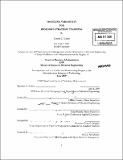Modeling variability for biologics strategic planning
Author(s)
Conant, Tamara L. (Tamara Lynn)
DownloadFull printable version (45.28Mb)
Other Contributors
Leaders for Manufacturing Program.
Advisor
Charles Cooney and Ernst Berndt.
Terms of use
Metadata
Show full item recordAbstract
Making strategic decisions about resource capabilities in the uncertain business of drug development is a challenging task. Novartis, a Swiss pharmaceutical company, is expanding from its success in small molecule therapeutics into the attractive area of biologic therapeutics, both monoclonal antibody and microbial forms. While Novartis has experience developing these types of therapeutics, they have not fully-developed the quantity that the Research group expects to source the pipeline with in the next few years. Therefore the Development group needs to grow. Determining the right number and type of scientists and technicians to hire is difficult due to the variability in the portfolio. The long development timelines, low and variable success rates impact how projects progress through the pipeline. A Monte Carlo simulation model forecasts variability and displays a numerical range of projects and headcount requirements expected for several years. This data is essential for project managers, function heads, and operations leaders to develop the five-year strategic plan for biologic development. This model quantifies the uncertainty of input variables to deliver a calculated risk of output variables, which provides useful and important information for making strategic business decisions.
Description
Thesis (S.M.)--Massachusetts Institute of Technology, Dept. of Electrical Engineering and Computer Science; and, (M.B.A.)--Massachusetts Institute of Technology, Sloan School of Management; in conjunction with the Leaders for Manufacturing Program at MIT, 2009. Cataloged from PDF version of thesis. Includes bibliographical references (p. 46).
Date issued
2009Department
Leaders for Manufacturing Program at MIT; Massachusetts Institute of Technology. Department of Electrical Engineering and Computer Science; Sloan School of ManagementPublisher
Massachusetts Institute of Technology
Keywords
Electrical Engineering and Computer Science., Sloan School of Management., Leaders for Manufacturing Program.